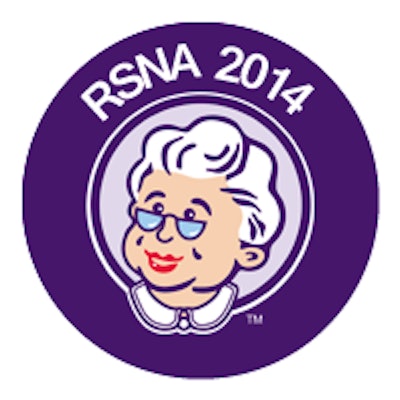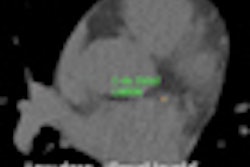
CHICAGO - Fast-moving coronary arteries exert a huge influence on coronary calcium scores, but not all scores go in the same direction, according to a study from the University of Groningen in the Netherlands.
In a study of four state-of-the-art scanners from different vendors, the scanners produced large variations in calcium scores when the coronary arteries were at rest, and even more so when they were in motion, mimicking a fast-beating heart. But while scores rose for some lesions, they dropped for others -- to the point where the effects of iterative reconstruction were comparatively tiny.
"The influence of motion on coronary calcium scores is much larger than the influence of iterative reconstruction," said Marcel Greuter, PhD, in his Monday presentation at RSNA 2014. "For fast-moving arteries, calcium scores are overestimated or underestimated depending on the density of the calcifications."
Coronary arteries can move quickly during cardiac scans, reaching velocities of up to 60 mm/sec. The effect on coronary calcium scores has not been comprehensively studied in the newest CT scanners and low-dose protocols.
Principal investigator Niels can der Werf, along with Greuter, Dr. Martin Willemink and colleagues, sought to determine the effect of motion on calcium scores in iterative reconstruction CT using new scanners from the four major vendors:
- GE Healthcare: Discovery CT750 HD
- Siemens Healthcare: Somatom Definition Flash with sinogram affirmed iterative reconstruction (SAFIRE)
- Philips Healthcare: Brilliance iCT with iDose
- Toshiba Medical Systems: Aquilion One with adaptive iterative dose reduction (AIDR)
To simulate a patient with calcifications, an anthropomorphic phantom representing an average-sized patient was packed with calcium hydroxyapatite-containing cylinders (volume: 198.4 mm3; mass: 157.1 to 38.5 mg). A computer-controlled motion simulator moved the phantom to represent a beating heart at speeds of 0 to 60 mm/sec.
Five scans at different motion speeds were acquired using each of the four scanners. For image reconstruction, the group used filtered back projection and three levels of iterative reconstruction to look for calcium score differences based on several combinations, quantifying with both Agatston and mass scores and a threshold of 130 HU for calcium.
For all of the scanner models, in both Agatston and mass scores, there was a change in calcium score as a function of velocity, Greuter said. For the 157.1 mg calcification, there were large variations in Agatston score across all scanner models, even without motion, and smaller differences were seen for smaller calcium samples.
"At velocities of 60 mm/sec, you see an overestimation of the high-density calcifications, up to 209%," on Agatston scores, Greuter said. "However, if you look at the low-density calcifications of 38 mg, we see an underestimation of the calcium score, up to 76%."
| Agatston scores by calcium density and vendor | |||||
| Calcium density | Velocity | GE | Siemens | Philips | Toshiba |
| 157 mg | 0 mm/sec | 421 | 419 | 418 | 450 |
| 60 mm/sec | 1,301 | 855 | 653 | 920 | |
| 80 mg | 0 mm/sec | 328 | 312 | 314 | 338 |
| 60 mm/sec | 476 | 515 | 404 | 552 | |
| 74 mg | 0 mm/sec | 312 | 289 | 270 | 311 |
| 60 mm/sec | 408 | 388 | 280 | 382 | |
| 38 mg | 0 mm/sec | 115 | 106 | 90 | 121 |
| 60 mm/sec | 81 | 25 | 87 | 52 | |
The same trends were seen with mass scores, only with smaller differences, Greuter said.
The effects of iterative reconstruction were smaller than the effects of motion. For the 157.1 mg calcification, the calcium scores using filtered back projection were 414 ± 12 for Philips, 414 ± 13 for Siemens, 427 ± 30 for GE, and 460 ± 11 for Toshiba at 0 mm/sec.
Speeding things up to 60 mm/sec, the Agatston scores increased 64% to 182% to reach 838 ± 88 for Philips, 682 ± 73 for Siemens, 1,205 ± 128 for GE, and 940 ± 47 for Toshiba, the authors wrote in their abstract.
When iterative reconstruction was turned up to the highest of its three levels, there was a 2% to 5% reduction in calcium scores relative to filtered back projection, down to 820 ± 89 for Philips, 645 ± 72 for Siemens, 1,176 ± 125 for GE, and 918 ± 44 for Toshiba. Meanwhile, low-density scores dropped by up to 13%.
Similarly, mass scores were reduced by about 3% for high-density calcifications and by about 14% for low-density calcifications, Greuter reported.
"We see a large variation in Agatston and mass scores at rest between the different CT systems," he said. "We see an underestimation of physical mass for most CT systems."
The influence of motion on coronary calcium scores is much larger than the influence of iterative reconstruction, he concluded. Faced with motion, mass scores are more stable than Agatston scores, and the influence of iterative reconstruction ranges from about 3% for high-density calcium to 14% for low-density calcium.




















